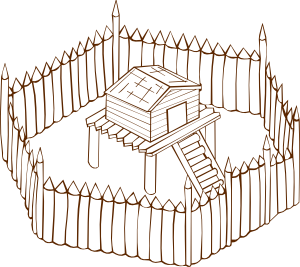 Here’s a website that’s fun to explore for Pryors. Check out this Netherland genealogy site at https://www.genealogieonline.nl. Don’t worry, you don’t need to know too much Dutch to navigate the site. The search field is at the top of the page labeled “zoeken”. The results are pretty sparse, mostly birth (“geboren”) and death (“overleden”) dates, however these may be helpful for your research out of the US or American colonies. Feeling unadventurous? Then click the little American/British flag at the top of the site and it will display the results in English. I found several of my non-Pryor kin in the site, giving me some new tips to explore.
Here’s a website that’s fun to explore for Pryors. Check out this Netherland genealogy site at https://www.genealogieonline.nl. Don’t worry, you don’t need to know too much Dutch to navigate the site. The search field is at the top of the page labeled “zoeken”. The results are pretty sparse, mostly birth (“geboren”) and death (“overleden”) dates, however these may be helpful for your research out of the US or American colonies. Feeling unadventurous? Then click the little American/British flag at the top of the site and it will display the results in English. I found several of my non-Pryor kin in the site, giving me some new tips to explore.
Monthly Archives: June 2015

New info on a John Pryor. Remember “Old” Joseph Pryor from White County, TN? The guy who was associated with Robert Armstrong? (see post on Robert Armstrong in IL and see post on Joseph Pryor in Delaware). Well, I stumbled upon an interesting coincidence or perhaps a piece of information that will help White County researchers with their line– it’s a Pryor and a Robert Armstrong. This is a record from the Revolutionary War:
Return of Capt. (Isaac) Alexander, A List of Men Belonging to My Company That Neglected Attending On The Three Muster Days That Commenced The First of November 1778: List includes John Pryor, Robert Armstrong (from Delaware Archives, Volume 2 By Delaware. Public Archives Commission, page 782 — go to Google Books)

It seems like when you start looking at Pryors on Kentucky frontier, really the areas the the west of Virginia, pioneer Pryor tales pop up everywhere. I’ve read in the past this story of Mary Pryor’s capture by Native Americans. It begs a second look.
The maternal grandfather, Thomas Mounts, served for seven years as a spy in the American army during the Revolutionary war, and later in the same capacity among the Indians… The paternal grandmother of Mrs. Stewart was MARY PRIOR, in whose life history occured chapters as exciting and thrilling as any to be found in strange tales of fiction. Her girlhood was mostly passed in her parent’s home on the Kentucky frontier, during a period when the Indians were particularly troublesome and vicious. She was a maiden of fourteen years when she, with her mother and a babe of six months, were stolen by the Indians, who massacred her father, the rest of the family and a number of negro slaves. Later the babe was killed and the mother, because she refused to dance around the body of her infant, was bound to a tree and burned by the infuriated savages. The Indians then crossed the Ohio river with their girl prisoner and for ten days traveled through the timber to their village. When the young braves started upon another raid the maiden was left in charge of the squaws and older Indians, but escaped and , traveling in the night, hid by day in hollow logs, subsisting on roots found in the forest. On the ninth day after her escape the Indians, close in pursuit, passed directly over the hollow log in which she lay, and while there hiding she was bitten by a snake. However, she had learned what roots to use in such emergency, and after applying them was forced to lie still for three days. Once more resuming her journey she came to the Ohio river, across which she was forced to swim. In the meantime the Indians were trying to find her and the United States soldiers from a Kentucky fort had been detailed to search for her, but evading the former and missing the latter, she made her way alone to the fort, where she was adopted by one of the officers, retaining, however her own name.
The Centennial History of Oregon, 1811-1912, Volume 4, page 880. Joseph Gaston, S.J. Clarke publishing Company, 1912. Mary’s son was William Scott, the father of Mary (Scott) Stewart who provided the story for this book. Mrs. Stewart was 91 years old, born in 1821 in Switzerland Co., IN, when she gave this account of Mary Prior.
John Scott and his wife Mary Prior (Pryor) lived in the Greenbrier Area in the 1700’s. Greenbrier County, formerly Montgomery County is now Monroe County in West Virginia. (see themorrisclan.com)
If we follow the trail left by folks researching this line and Find A Grave memorials we may be able to derive when Miss Pryor was born and when she was a young girl living on the frontier. Her son Joseph Scott is purported to have been born in 1775 (see his grave marker). If she was a young maiden of 14 when captured then it was probably some time before his birth, which would put her birth perhaps in the late 1750’s.
I’ve seen comments online that there were few people living in this area and it makes her grand-daughter’s story somewhat doubtful. I think there’s some strong rings of truth in the story. If we go back to the Battle of Point Pleasant in 1774 we know that Virginians were pushing into the frontier. Fort Randolph was built in 1776.
I see that some family history researchers have stated Mary’s father was John Pryor. That may have drawn that conclusion because it parallels the story of the end of John Pryor “saviour of the Greenbrier” with the capture of his wife and baby. However, the attack involving Mary Pryor was probably decades before the death of frontiersman John Pryor. I recollected another attack– Moses Pryor and his family at Griffin’s Station in Ohio, but that also occurred later (probably in 1792 or 1793).
So if the story of Mary Pryor is a true tale, then it’s describing events in the frontier during the years leading up the Revolutionary War, perhaps shortly before or at about the time of Lord Dunmore’s War.
John Thickston is another signer of the Low Dutch Petition of 1783 that also ties the other signers to Jefferson County, near Louisville. Thickston is identified in THE LOW DUTCH COMPANY “A History of the Holland Dutch Settlements of the Kentucky Frontier” by Vincent Akers, published in 1980. Pulling information from this book and from “Early Kentucky Settlers: The Records of Jefferson County, Kentucky, from the Filson Club History Quarterly”
- “In the summer of 1780 John and Christopher Westerfield decided to move their families to Harrodstown. They hired JOHN THICKSTON, one of Floyd’s scouts, to guide the party and help carry the baggage on his two horses.” This is the John Floyd who built Floyd’s station on Beargrass Creek. Also mentioned is Bullett’s Lick.
- 1782 John Thixton (sic) with John Pryor in Jefferson County, KY cast their votes for John May as a delegate to the Virginia Assembly
- 1783 John Thickston signed the Low Dutch Petition a few lines above John Prior. (Other signers who also were polled in 1782 are Cornelius Bryan, William Cummins, William Goodwin, James Hoagland/Houghland, and Samuel Westerfield).
 William Haynes is yet another new lead on the Pryors from a name in David Crawford’s 1801 will. Crawford was from Amherst County, VA and filed his will in Jefferson County, KY. The will was witnessed by William Pryor and John Pryor. He mentions land, presumably in KY, that he had purchased from William Haynes.
William Haynes is yet another new lead on the Pryors from a name in David Crawford’s 1801 will. Crawford was from Amherst County, VA and filed his will in Jefferson County, KY. The will was witnessed by William Pryor and John Pryor. He mentions land, presumably in KY, that he had purchased from William Haynes.
1801 – Jefferson Co., KY Will
David Crawford, 14 Dec 1801 — 20 Sept 1802; 4 Mar 1805.
To sons David and Reuben, land on Harrods Creek; to Nathan land in Shelby County where he now lives; to daughter Salley Cocke 80 pounds money, money also to daughters Elizabeth Davis and Nancy Jones; to son Charles land bought of Richard Talliaferro adjoining Elias Wells [or Wills]; to sons Nelson and William land in Amherst County, adjoining Buffalo Ridge, granted testator in 1789; to my wife part of land where “I now live,” bought of Robert Johnston and William Haynes; special gift to Nathan “for him not receiving assistance in setting out in life in a remote and distant country”; to son John one half of all lands in Kentucky seruveyed by him.
Exec. Sons John, William S., Nelson and Charles [Crawford]
Bondsman: Charles Taliaferro, Nathaniel Warwick
Witnesses: William Pryor, John Pryor, Stella Sullivan.
Codical dated 14 Mar 1802. Land to son William to be sold and “divided among my legatees”; son John to manage estate. Sons David and Reuben to be “given equally as much as my other children.”
Witnesses: William Pryor and John Pryor, Stella Sullivan.
This may be the same William Haynes and the same William Pryor who appear on a deed in 1805 Stewart County, TN. Just a refresher… That Pryor was likely the William Pryor who was part of Austin’s colony who claimed birth in Botetourt County, VA (see post).
Stewart County, TN. William PRYOR to William HAYNES, 314a; wit: Benjamin DOWNS, W. M. HICKS; 4 Mar 1805
One researcher is looking for a William Haynes who married a Mary Pryor. They point to William and Mary Haynes in MO:
1850 Census Audrain Co., MO
Dist. 4, page 172B, house 245/263 William Haynes 75 farmer VA, Mary 69 VA
1860 Census Sullivan Co., MO
Milan PO, sheet 150, house 1025 Samuel T. Haynes 55 farmer & doctor VA, Nancy 42 KY, Jesse R. 18 MO, Rebecca 12 MO, Malissa C. 10 MO, John W. 7 MO, Hannah 5 MO, Lucinda F. 1 MO, Samuel Parmely 42 KY, William Haynes 86 farmer KY
The William Haynes in MO lived to a ripe ol’ age. He was counted on the 1870 Census at age 96.
I don’t see any independent documentation that states William Haynes married Mary Pryor. I’d be interested in hearing from anyone who has discovered a source for her Pryor surname.
I may have had an “AH-HA” moment. William Haynes is on the 1830 Census in Callaway County, MO. I noticed an interesting name on the same page… Robert McClelland. I wonder if this is the same man who was married to Nancy Pryor in 1792 in Jefferson County, KY. McClelland was explorer Nathaniel Pryor’s brother in law– it’s reported that his gravestone was found on William Clark‘s Missouri farm (see article). So, isn’t it interesting that Mr. Haynes from Jefferson County, KY may be counted on the same page with McClelland who was also from Jefferson County and closely associated with the Pryors.

